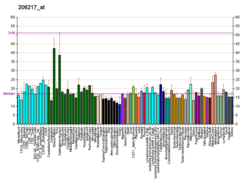Ectodysplasin A (EDA) is a protein that in humans is encoded by the EDA gene.
Ectodysplasin A is a transmembrane protein of the TNF family which plays an important role in the development of ectodermal tissues such as skin in humans.[5][6] It is recognized by the ectodysplasin A receptor.
- ^ a b c GRCh38: Ensembl release 89: ENSG00000158813 – Ensembl, May 2017
- ^ a b c GRCm38: Ensembl release 89: ENSMUSG00000059327 – Ensembl, May 2017
- ^ "Human PubMed Reference:". National Center for Biotechnology Information, U.S. National Library of Medicine.
- ^ "Mouse PubMed Reference:". National Center for Biotechnology Information, U.S. National Library of Medicine.
- ^ Kere J, Srivastava AK, Montonen O, Zonana J, Thomas N, Ferguson B, Munoz F, Morgan D, Clarke A, Baybayan P, Chen EY, Ezer S, Saarialho-Kere U, de la Chapelle A, Schlessinger D (Sep 1996). "X-linked anhidrotic (hypohidrotic) ectodermal dysplasia is caused by mutation in a novel transmembrane protein". Nat Genet. 13 (4): 409–16. doi:10.1038/ng0895-409. PMID 8696334. S2CID 25690815.
- ^ "Entrez Gene: EDA ectodysplasin A".





